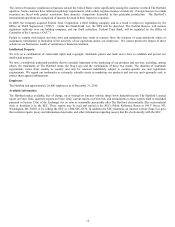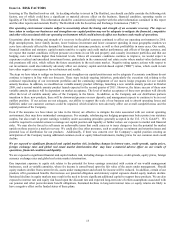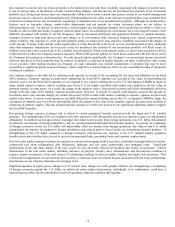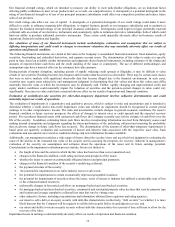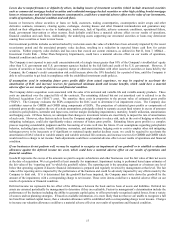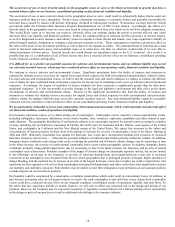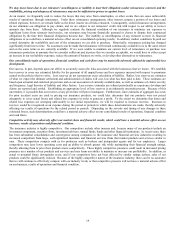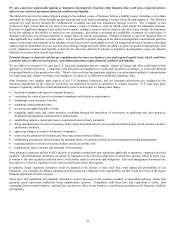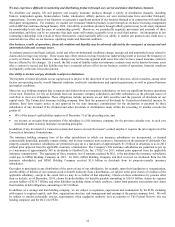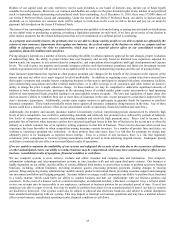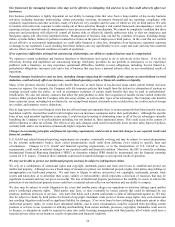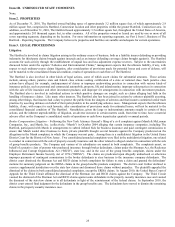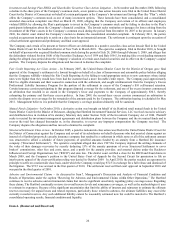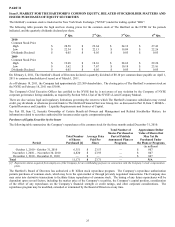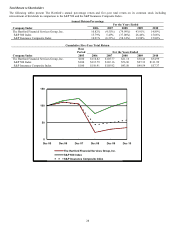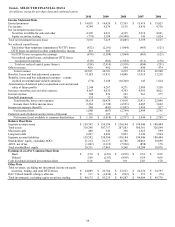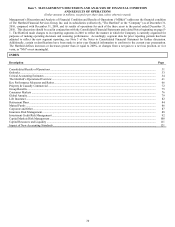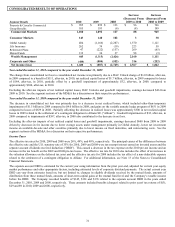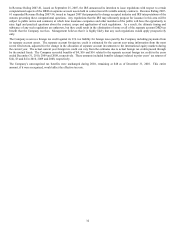The Hartford 2010 Annual Report Download - page 22
Download and view the complete annual report
Please find page 22 of the 2010 The Hartford annual report below. You can navigate through the pages in the report by either clicking on the pages listed below, or by using the keyword search tool below to find specific information within the annual report. 22
We may experience difficulty in marketing and distributing products through our current and future distribution channels.
We distribute our annuity, life and property and casualty insurance products through a variety of distribution channels, including
brokers, independent agents, broker-dealers, banks, wholesalers, affinity partners, our own internal sales force and other third-party
organizations. In some areas of our business, we generate a significant portion of our business through or in connection with individual
third-party arrangements. For example, we market our Consumer Markets products in part through an exclusive licensing arrangement
with AARP that continues through January 2020. Our ability to distribute products through affinity partners may be adversely impacted
by membership levels and the pace of membership growth. Moreover, we periodically negotiate provisions and renewals of these
relationships, and there can be no assurance that such terms will remain acceptable to us or such third parties. An interruption in our
continuing relationship with certain of these third parties could materially affect our ability to market our products and could have a
material adverse effect on our business, operating results and financial condition.
Our business, results of operations, financial condition and liquidity may be adversely affected by the emergence of unexpected and
unintended claim and coverage issues.
As industry practices and legal, judicial, social and other environmental conditions change, unexpected and unintended issues related to
claims and coverage may emerge. These issues may either extend coverage beyond our underwriting intent or increase the frequency or
severity of claims. In some instances, these changes may not become apparent until some time after we have issued insurance contracts
that are affected by the changes. As a result, the full extent of liability under our insurance contracts may not be known for many years
after a contract is issued, and this liability may have a material adverse effect on our business, results of operations, financial condition
and liquidity at the time it becomes known.
Our ability to declare and pay dividends is subject to limitations.
The payment of future dividends on our capital stock is subject to the discretion of our board of directors, which considers, among other
factors our operating results, overall financial condition, credit-risk considerations and capital requirements, as well as general business
and market conditions.
Moreover, as a holding company that is separate and distinct from our insurance subsidiaries, we have no significant business operations
of our own. Therefore, we rely on dividends from our insurance company subsidiaries and other subsidiaries as the principal source of
cash flow to meet our obligations. These obligations include payments on our debt securities and the payment of dividends on our
capital stock. The Connecticut insurance holding company laws limit the payment of dividends by Connecticut-domiciled insurers. In
addition, these laws require notice to and approval by the state insurance commissioner for the declaration or payment by those
subsidiaries of any dividend if the dividend and other dividends or distributions made within the preceding 12 months exceeds the
greater of:
• 10% of the insurer’ s policyholder surplus as of December 31 of the preceding year, and
• net income, or net gain from operations if the subsidiary is a life insurance company, for the previous calendar year, in each case
determined under statutory insurance accounting principles.
In addition, if any dividend of a Connecticut-domiciled insurer exceeds the insurer’ s earned surplus, it requires the prior approval of the
Connecticut Insurance Commissioner.
The insurance holding company laws of the other jurisdictions in which our insurance subsidiaries are incorporated, or deemed
commercially domiciled, generally contain similar, and in some instances more restrictive, limitations on the payment of dividends. Our
property-casualty insurance subsidiaries are permitted to pay up to a maximum of approximately $1.5 billion in dividends to us in 2011
without prior approval from the applicable insurance commissioner. The Company’ s life insurance subsidiaries are permitted to pay up
to a maximum of approximately $83 in dividends to Hartford Life, Inc. (“HLI”) in 2011 without prior approval from the applicable
insurance commissioner. The aggregate of these amounts, net of amounts required by HLI, is the maximum the insurance subsidiaries
could pay to HFSG Holding Company in 2011. In 2010, HFSG Holding Company and HLI received no dividends from the life
insurance subsidiaries, and HFSG Holding Company received $1.0 billion in dividends from its property-casualty insurance
subsidiaries.
Our rights to participate in any distribution of the assets of any of our subsidiaries, for example, upon their liquidation or reorganization,
and the ability of holders of our common stock to benefit indirectly from a distribution, are subject to the prior claims of creditors of the
applicable subsidiary, except to the extent that we may be a creditor of that subsidiary. Claims on these subsidiaries by persons other
than us include, as of December, 2010, claims by policyholders for benefits payable amounting to $116.9 billion, claims by separate
account holders of $159.7 billion, and other liabilities including claims of trade creditors, claims from guaranty associations and claims
from holders of debt obligations, amounting to $13.9 billion.
In addition, as a savings and loan holding company, we are subject to regulation, supervision and examination by the OTS, including
with respect to required capital, cash flow, organization structure, risk management and earnings at the parent company level. We will
be subject to similar, potentially stricter, requirements when regulatory authority over us transfers to The Federal Reserve (for our
holding company) and the OCC (for FTB).


